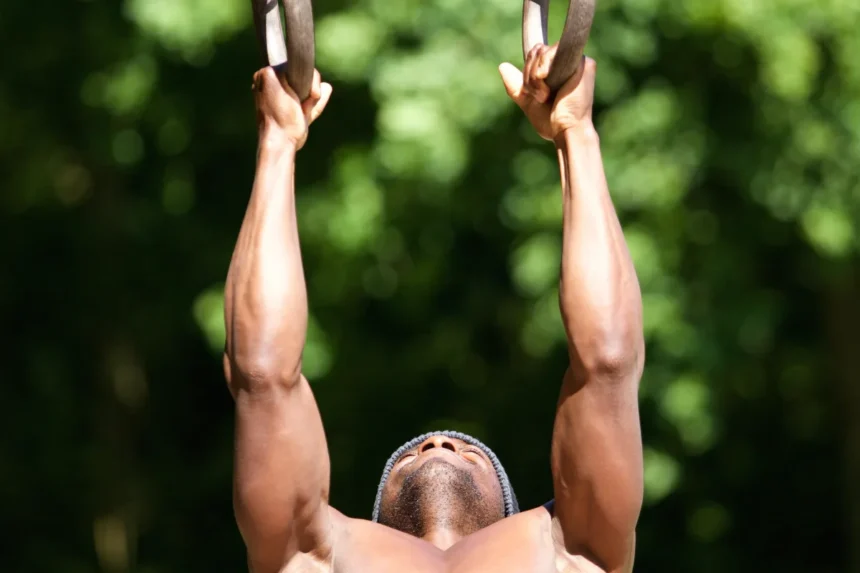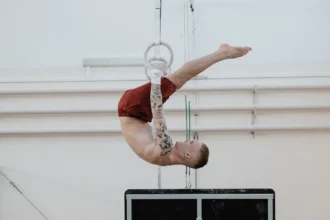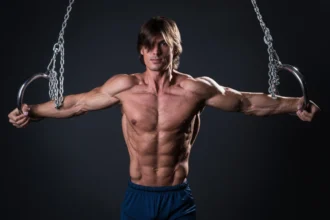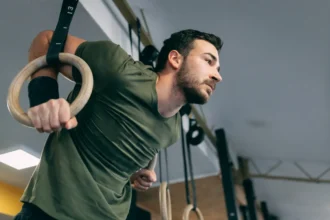Gymnastic rings are one of the best tools for building real-world strength. Unlike machines or fixed bars, rings move freely, forcing your body to stabilize through every rep. In this guide, you’ll learn everything you need to know about pulling exercises on rings.
Why Focus on Pulling Exercises with Rings?
Pulling movements are essential for a strong, balanced body. They target your posterior chain, muscles like your lats, rhomboids, traps, biceps, and even your core. On rings, you’ll train two main patterns:
- Vertical pulling – Exercises like chin-ups, where you pull your body upward.
- Horizontal pulling – Exercises like rows, where you pull yourself toward the rings.
Together, these movements build strength, muscle endurance, and the foundation for advanced skills like front levers, back levers, and even muscle-ups.
Warm-Up: Preparing the Shoulders and Back
Before attempting pulling exercises, it’s important to prime your joints and muscles. Rings demand stability, so a few minutes of prep goes a long way.
1. Scapular Pull-Ups
- Hang passively from the rings.
- Engage your core and pull your shoulder blades down without bending your elbows.
- Perform 12 reps.
👉 This activates your lats and teaches proper scapular control.
2. Scapular Circles
- Set the rings low and lean back.
- Keep arms straight and move your shoulders through retraction, elevation, protraction, and depression.
- Do 5 reps each way.
👉 Improves shoulder mobility and stability.
3. Shoulder Dislocates
- Use a stick or resistance band.
- Bring it over your head and behind your body in a smooth arc.
- Start wide, then narrow your grip gradually.
- Perform 10 reps.
👉 Opens up the chest and prepares your shoulders for deep pulling angles.
Main Pulling Exercises on Rings
These are your primary strength builders on rings. Start with the basics, then progress as you gain control.
1. Ring Chin-Ups (Vertical Pulling)
One of the best pulling exercises for beginners. Rings rotate naturally, making them easier on your joints.
- Grab the rings with palms facing you.
- Think of pulling the rings down instead of lifting yourself up.
- Keep your body tight and avoid swinging.
Levels:
- Beginner: 8–10 reps
- Intermediate: Add a 2-second pause at mid-range
2. Unilateral Ring Rows (Horizontal Pulling)
This variation mimics real-life pulling—like dragging something heavy—while engaging your core.
- Set rings at hip height.
- Grab one ring, step back, and let your torso rotate as you row.
- Touch the strap with your free hand to keep reps honest.
Levels:
- Beginner: 8–10 reps, 3 steps back
- Intermediate: 8–10 reps, 1 step back (harder angle)
3. Inverted Hang
A unique pulling drill that builds scapular strength while inverted.
- Set rings just high enough so your head won’t hit the ground if you lose balance.
- Curl up into an inverted position until stable.
- Hold the position with scapular engagement.
Levels:
- Beginner: Hold 10–20s with knees tucked
- Intermediate: Hold with legs straight in hollow body position
Accessory Pulling Work
These exercises strengthen smaller muscle groups and improve posture, tendon strength, and stability.
1. Face Pulls
- Rings below hip height, step back 3–4 steps.
- Pull rings toward your face, elbows bent at 90°.
- Squeeze at the top, then lower with control.
Levels:
- Beginner: 10–12 reps, 4 steps back
- Intermediate: Same reps, 2 steps back
👉 Strengthens rear delts, rotator cuff, and scapular retraction.
2. Pronated Bicep Curls
- Grab the rings with palms facing down.
- Keep elbows in front of you as you curl upward.
- Maintain full-body alignment.
Levels:
- Beginner: 10 reps, 3 steps back
- Intermediate: 10 reps, 2 steps back
👉 Builds tendon strength and arm control for advanced pulling moves.
3. Ring Rollouts
A tough core exercise that complements pulling strength.
- Set rings at ankle height.
- With feet under the anchor, extend arms forward while keeping your hips tucked.
- Don’t let your lower back arch.
Levels:
- Beginner: Feet directly under the anchor
- Intermediate: Start 2 steps behind the anchor
👉 Builds hollow body control needed for front lever and planche.
Cool-Down: Reset the Body
After heavy pulling, balance things out with a calming finish.
- Shaking (3–5 min): Gently shake out arms and legs to relax.
- Stillness (5 min): Sit or lie quietly to regulate breathing and nervous system.
Quick Workout Table
| Exercise | Focus | Beginner | Intermediate |
|---|---|---|---|
| Scapular Pull-Ups | Shoulder control | 12 reps | 12 reps |
| Scapular Circles | Mobility | 5 each way | 5 each way |
| Shoulder Dislocates | Mobility | 10 reps | Narrower grip |
| Ring Chin-Ups | Vertical pull | 8–10 reps | +2s pause |
| Unilateral Ring Rows | Horizontal pull | 8–10 reps, 3 steps back | 8–10 reps, 1 step back |
| Inverted Hang | Scapular control | 10–20s tuck | 10–20s straight legs |
| Face Pulls | Posture/rear delts | 10–12 reps, 4 steps back | 10–12 reps, 2 steps back |
| Pronated Bicep Curls | Arms | 10 reps, 3 steps back | 10 reps, 2 steps back |
| Ring Rollouts | Core | 10–12 reps, feet under | 10–12 reps, 2 steps back |
Progression Path
- Beginner: Rows, chin-ups, face pulls, curls.
- Intermediate: Add holds, pauses, stricter angles.
- Advanced: Build toward front lever, back lever, and muscle-ups.
This gymnastic rings pulling workout gives beginners everything they need: strength, control, posture, and joint-friendly progressions. Stick with these movements consistently and you’ll not only develop pulling power but also lay the foundation for advanced skills like muscle-ups and levers.






